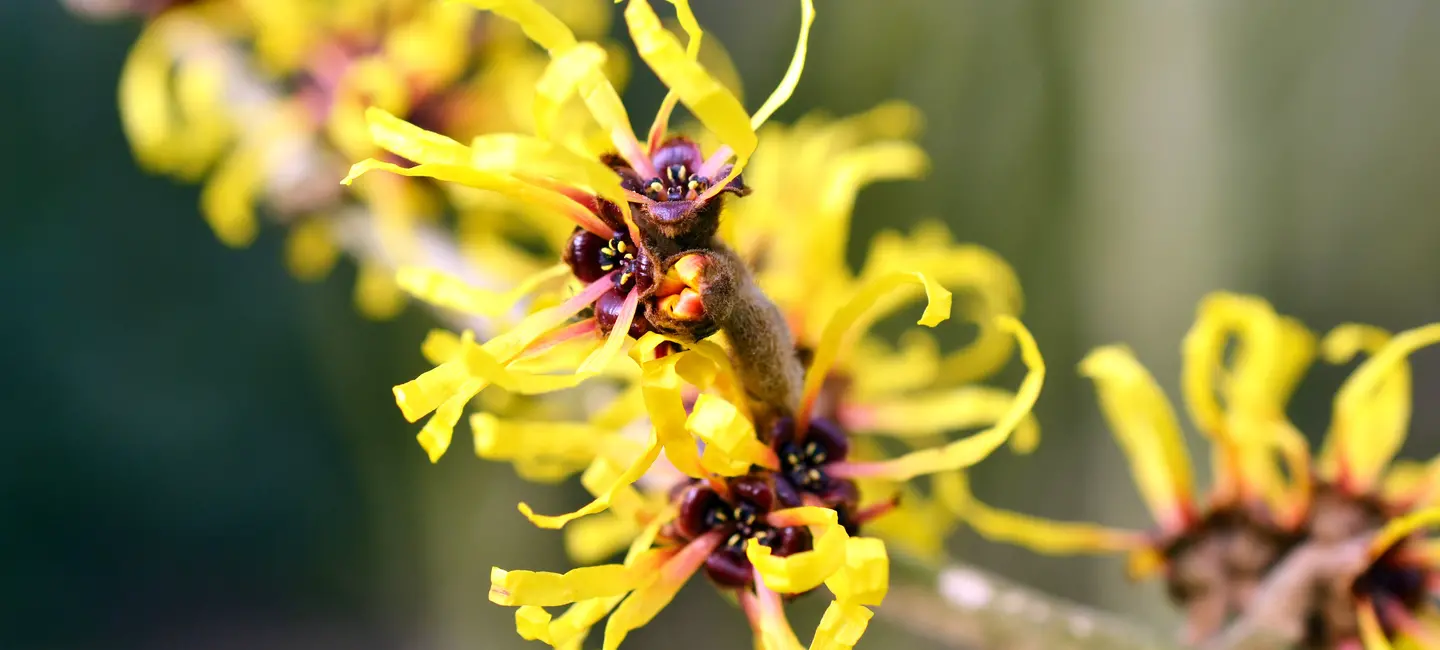
Witch hazel is a plant. The leaf, bark, and twigs are used to make medicine. You may see a product called witch hazel water (Hamamelis water, distilled witch hazel extract). This is a liquid that is distilled from dried leaves, bark, and partially dormant twigs of witch hazel.
Witch hazel is taken by mouth for diarrhea, mucus colitis, vomiting blood, coughing up blood, tuberculosis, colds, fevers, tumors, and cancer.
Some people apply witch hazel directly to the skin for itching, pain and swelling (inflammation), eye inflammation, skin injury, mucous membrane inflammation, vaginal dryness after menopause, varicose veins, hemorrhoids, bruises, insect bites, minor burns, acne, sensitive scalp, and other skin irritations.
In manufacturing, witch hazel leaf extract, bark extract, and witch hazel water are used as astringents to tighten the skin. They are also included in some medications to give those products the ability to slow down or stop bleeding. Those medications are used for treating insect bites, stings, teething, hemorrhoids, itching, irritations, and minor pain.
Is It Effective?
NatMed Pro rates effectiveness based on scientific evidence according to the following scale: Effective, Likely Effective, Possibly Effective, Possibly Ineffective, Likely Ineffective, Ineffective, and Insufficient Evidence to Rate.
- Hemorrhoids. Applying witch hazel water to the skin may help to temporarily relieve itching, discomfort, irritation, and burning from hemorrhoids and other anal disorders.
- Minor bleeding. Applying witch hazel bark, leaf, or water to the skin reduces minor bleeding.
- Skin irritation. Applying witch hazel cream seems to relieve mild skin irritation, but not as well as hydrocortisone. Other research shows that applying a specific witch hazel ointment (Hametum) to the skin appears to improve symptoms of skin injury or irritated skin as effectively as a dexpanthenol ointment in children.
- Itchy and inflamed skin (eczema). Applying a cream containing witch hazel to the skin for 14 days does not seem to improve itchy and inflamed skin in people with moderate eczema. Applying hydrocortisone cream seems to be a more effective treatment option.
- Health problems after menopause. Early research shows that applying a cream containing witch hazel into the vagina can reduce feelings of vaginal dryness in postmenopausal women.
- Bruises.
- Colds.
- Coughing up blood.
- Diarrhea.
- Eye inflammation.
- Fevers.
- Tuberculosis.
- Varicose veins.
- Vomiting blood.
- Other conditions.
More evidence is needed to rate the effectiveness of witch hazel for these uses.
Is it Safe?
Witch hazel contains chemicals called tannins. When applied directly to the skin, witch hazel might help reduce swelling, help repair broken skin, and fight bacteria.
Witch hazel is LIKELY SAFE for most adults when applied directly to the skin. In some people, it might cause minor skin irritation.
Witch hazel is POSSIBLY SAFE for most adults when small doses are taken by mouth. In some people, witch hazel might cause stomach upset when taken by mouth. Large doses might cause liver problems.
Witch hazel contains a cancer-causing chemical (safrole), but in amounts that are too small to be of concern.
Special Precautions & Warnings:
Children: Witch hazel is POSSIBLY SAFE for children when applied directly to the skin.
Pregnancy and breast-feeding: There is not enough reliable information about the safety of taking witch hazel if you are pregnant or breast-feeding. Stay on the safe side and avoid use.
It is not known if Witch Hazel interacts with any medicines. Before taking Witch Hazel, talk with your healthcare professional if you take any medications.
There are no known interactions with herbs and supplements.
There are no known interactions with foods.
The following doses have been studied in scientific research:
ADULTS
APPLIED TO THE SKIN:
- For skin irritation: An after sun lotion containing 10% witch hazel water has been used.
APPLIED TO THE ANUS:
- For itching and discomfort associated with hemorrhoids and other anal disorders: Witch hazel water has been applied up to 6 times per day or after every bowel movement. Suppositories have been placed in the anus 1-3 times per day.
CHILDREN
APPLIED TO THE SKIN:
- For skin irritation: An ointment containing witch hazel has been applied several times per day in children aged 2-11 years.
Avellano de Bruja, Café du Diable, Hamamelis, Hamamélis, Hamamélis de Virginie, Hamamelis virginiana, Hazel, Noisetier des Sorcières, Snapping Tobacco Wood, Spotted Elder, Virginian Witch Hazel, Winter Bloom.
Information on this website is for informational use only and is not intended to replace professional medical advice, diagnosis, or treatment. While evidence-based, it is not guaranteed to be error-free and is not intended to meet any particular user’s needs or requirements or to cover all possible uses, safety concerns, interactions, outcomes, or adverse effects. Always check with your doctor or other medical professional before making healthcare decisions (including taking any medication) and do not delay or disregard seeking medical advice or treatment based on any information displayed on this website.
© TRC Healthcare 2024. All rights reserved. Use and/or distribution is permitted only pursuant to a valid license or other permission from TRC Healthcare.
